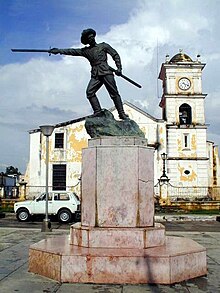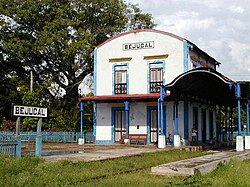Municipality in Mayabeque, Cuba
Bejucal is a municipality and town in the Mayabeque Province of Cuba . It was founded in 1713.[ 1] Latin America in 1837. It also hosts one of the most popular and traditional carnival fest in Cuba: "Charangas de Bejucal". Bejucal has also been known as a telecommunications site, hosting broadcasts of several news and media networks.[ 4] Soviet nuclear warheads during the Cuban Missile Crisis .[ 5] signals intelligence listening station operated by the People's Liberation Army Third Department of the Joint Staff Department .[ 6] [ 7] [ 8]
Geography
The municipality borders to the north with Boyeros (a municipal borough of Havana ); to the east with San José de las Lajas ; to the south with Quivicán ; and on the west with San Antonio de los Baños .
It is divided into the barrios of Bejucal, Beltrán, Cuatro Caminos, Rancho Recreo, Buenaventura, Caguazo and Río Hondo.[ 1]
Demographics
In 2022, the municipality of Bejucal had a population of 28,205.[ 3] 2 (46 sq mi),[ 2] 2 (620/sq mi).
Notable residents
Notable current and former residents of Bejucal include:
See also
Bejucal Church
References
^ a b c Guije.com. "Bejucal" (in Spanish). Archived from the original on 12 October 2007. Retrieved 2007-10-07 . ^ a b Statoids (July 2003). "Municipios of Cuba" . Archived from the original on 12 October 2007. Retrieved 2007-10-07 . ^ a b "Cuba: Administrative Division (Provinces and Municipalities) - Population Statistics, Charts and Map" . www.citypopulation.de . Archived from the original on 2021-01-21. Retrieved 2024-02-03 .^ "Short-Wave Radio Frequency Schedule for site Bejucal" . Archived from the original on 2022-11-24. Retrieved 2024-06-07 .^ Dobbs, Michael (2008). One minute to midnight : Kennedy, Khrushchev, and Castro on the brink of nuclear war ISBN 978-1-4000-4358-3 OCLC 176951842 . Archived from the original on 2010-01-11. Retrieved 2024-06-07 . {{cite book }}: CS1 maint: date and year (link )^ "America and China try to move past a new bump in relations" The Economist ISSN 0013-0613 . Archived from the original on 2024-06-07. Retrieved 2023-06-16 .^ Gámez Torres, Nora (June 8, 2023). "In bold move challenging the United States, Cuba agrees to host a Chinese spy base" . Miami Herald Archived from the original on June 8, 2023. Retrieved June 16, 2023 . ^ "Secret Signals: Decoding China's Intelligence Activities in Cuba" . Center for Strategic and International Studies Archived from the original on 2024-07-02. Retrieved 2024-07-02 .^ Albio Sires Archived 2016-09-08 at the Wayback Machine , Biographical Directory of the United States Congress
External links
Bejucal at Wikimedia Commons
Places adjacent to Bejucal



